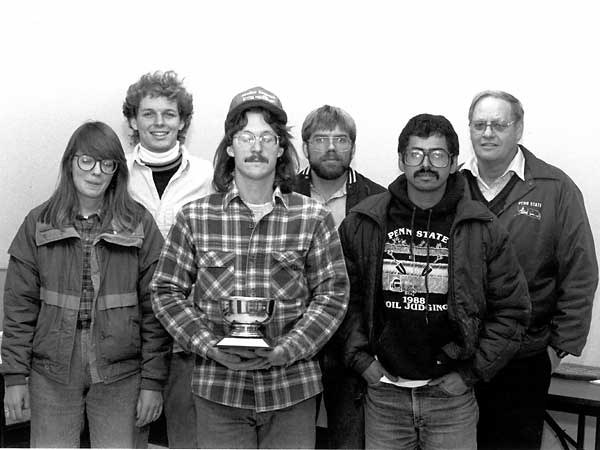Northeast Regional Collegiate Soil Judging Contest
October 22, 1988, Penn State
Team Members
- Ray Shipp, coach
- Steve Blecker, 1st place individual
- Jim Thompson, 4th place individual
- Cherie Moll, 6th place individual
- Hernando Uribe,11th place individual
- David Lapp
Overall Team Standings
- Penn State
University's soil judging team wins first place at contest
By AMY ELIZABETH BEGLEY
Collegian Staff Writer
The Penn State College of Agriculture soil judging team took first place at the Northeast Regional Soil Judging Contest held at the University's Rock Springs Agricultural Research Center last month.
By winning, the team qualified to compete in the National Collegiate Soil Judging Contest to be held in Texas this April, said Ray Shipp, associate professor of agronomy in the College of Agriculture and team coach.
One of the four members of the team, Steve Blecker (junior-environmental resource management), received first-place honors at the competition. Blecker, competing for his third semester, said his placing was his "best by far."
Two days prior to the competition, the teams view practice pits or soil profiles and meet with the judges to compare their descriptions of the soil, said James Thompson (junior-agronomy), who placed fourth in the individual scoring. Thompson was competing for his first semester.
Also competing for the team were Cherie Moll (senior-agronomy) and Hernando Uribe (senior-agronomy), who placed sixth and eleventh respectively.
Shipp said on the day of the competition, team members are separated and sent to view one of the four soil profiles that have been dug, prepared and described by official judges.
"The pits are about six feet deep, ten feet long and a couple of feet wide," said Blecker.
The students then have one hour to describe the uses and limitations, as well as the physical characteristics of the soil, Shipp said.
Moll, also competing for her first year, said determining what structures can be built upon the soil is a major factor in studying soil. Taking into consideration whether such things as basements or septic tanks can be built upon the soil is very important, she said.
The scores of the team members are then combined and compared to those of the official judges, and the team with the highest number of points wins. Individual scores are then examined for the results of the individual competition.
Shipp, who has coached the team for the past two years, also instructs Agronomy 100, the class that "prepares the students for competition," Shipp said. It gives the students a hands-on experience in describing the soil and predicting its usability, he said.
Blecker said the one-credit class is open to all majors. But to be selected for the team the student must be a four-year undergraduate and score high on a written and out-in-the-field exam he administers, Shipp added. "Each year the student must requalify," Blecker said.
Moll said the class meets for lectures on Tuesday evenings and performs fieldwork on Sundays.
Shipp, as the coach of the host team, was in charge of separating the teams and selecting the two official judges and the four pit monitors, who kept watch over the pits during the students' evaluations. Robert Dobos and Stephanie Gibas, both graduate students in agronomy and former members of soil judging teams, were the official judges, he said. Graduate students from the College of Agriculture also acted as monitors.
Thompson said there are seven regions in the United States and the first- and second-place winners of each regional competition are eligible to compete in the nationals. The University of Maryland placed second at the Oct. 22 competition.
Moll said due to the rotational basis of the contest, each team has the opportunity to host a regional competition.
Last year the team placed second in the regionals, Shipp said, and traveled to South Dakota where they placed 12th out of 17 teams.
Shipp said the College of Agriculture has a student activity fund that pays for a portion of the students' traveling expenses. Al Turgeon, department head of agronomy, also allots some departmental funding, Shipp said.



